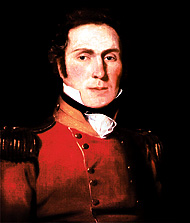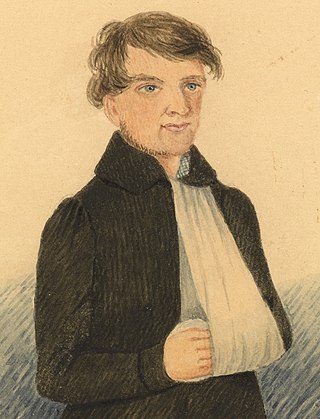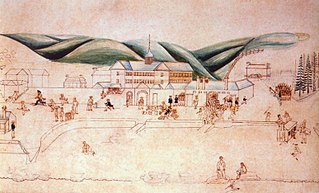Related Research Articles

The history of Norfolk Island dates back to the fourteenth or fifteenth century when it was settled by Polynesian seafarers.

Bushrangers were originally escaped convicts in the early years of the British settlement of Australia who used the bush as a refuge to hide from the authorities. By the 1820s, the term had evolved to refer to those who took up "robbery under arms" as a way of life, using the bush as their base.

Captain Patrick Logan was the commandant of the Moreton Bay Penal Settlement from 1826 until his death in 1830 at the hands of Aboriginal Australians. As he had been hated by convicts, there were rumours that escaped convicts living in the bush had attacked him, but there is no evidence of this.
D'Arcy Wentworth was an Irish-Australian surgeon and the first paying passenger to arrive in the new colony of New South Wales. He served under the first seven governors of the Colony, and from 1810 to 1821, he was "great assistant" to Governor Lachlan Macquarie. Wentworth led a campaign for the rights and recognition of emancipists and for trial by jury.
Alexander Maconochie was a Scottish naval officer, geographer and penal reformer.

John Piper was a military officer, public servant and landowner in the colony of New South Wales. The Sydney suburb of Point Piper was named in his honour.

Lieutenant Colonel James Thomas Morisset, penal administrator, was commandant of the second convict settlement at Norfolk Island, from 29 June 1829 to 1834.
Major Vance Young Donaldson, soldier and penal administrator, was born in Tyrone and entered the army at the age of thirteen, serving in the 57th Regiment under Wellington.
Major Joseph Childs (1787–1870) was a British Royal Marines officer and penal administrator; he was commandant of the second convict settlement at Norfolk Island, from 7 February 1844 to August 1846.
The history of Australia from 1788 to 1850 covers the early British colonial period of Australia's history. This started with the arrival in 1788 of the First Fleet of British ships at Port Jackson on the lands of the Eora, and the establishment of the penal colony of New South Wales as part of the British Empire. It further covers the European scientific exploration of the continent and the establishment of the other Australian colonies that make up the modern states of Australia.

Lawrence Kavenagh was an Irish-Australian convict bushranger who, with Martin Cash and George Jones, escaped from Port Arthur, Van Diemen's Land, in late 1842. The three men took to bushranging for a six-month period, robbing homesteads and inns with seeming impunity. Kavenagh was tried for serious crimes on five separate occasions. He was executed in 1846 at Norfolk Island.

William Westwood, also known as Jackey Jackey, was an English-born convict who became a bushranger in Australia.
Charles Fraser or Frazer or Frazier was Colonial Botanist of New South Wales from 1821 to 1831. He collected and catalogued numerous Australian plant species, and participated in a number of exploring expeditions. He was a member of the Stirling expedition of 1827, and his report on the quality of the soil was instrumental in the decision to establish the Swan River Colony.

The Bathurst Rebellion of 1830 was an outbreak of bushranging near Bathurst in the British penal colony of New South Wales.

Kingston and Arthurs Vale Historic Area (KAVHA) is an old settlement on the Kingston coastal plains, southern side of Norfolk Island, consisting of a large group of buildings from the British Empire's convict era (1788–1855), now considered to be of such cultural significance to Australia and to the World that the area has been formally inscribed onto both the Australian National Heritage List and UNESCO's World Heritage list as amongst:
" .. the best surviving examples of large-scale convict transportation and the colonial expansion of European powers through the presence and labour of convicts."

James Hardy Vaux was an English-born convict transported to Australia on three separate occasions. He was the author of Memoirs of James Hardy Vaux including A Vocabulary of the Flash Language, first published in 1819, which is regarded as both the first full length autobiography and first dictionary written in Australia.
Norfolk Island convict mutinies were a series of armed uprisings by convicts on the penal colony of Norfolk Island, Australia. All were unsuccessful.
John Whelan was an Irish-born bushranger and serial killer operating in the Huon Valley in 1855 in Van Diemen's Land. He was a tall man for his times, standing at 6’1” (185 cm) and of heavy build, and was nicknamed Rocky for the crags and deep pock marks of his face.

The Cooking Pot Uprising or Cooking Pot Riot was an uprising of convicts led by William Westwood in the penal colony of Norfolk Island, Australia. It occurred on 1 July 1846 in response to the confiscation of convicts' cooking vessels under the orders of the Commandant of the penal settlement, Major Joseph Childs.

From the late 1700s until the end of the 19th century, the British Empire established, expanded and maintained a number of colonies on the continent of Australia. These colonies included New South Wales, Van Diemen's Land, Western Australia, South Australia, Victoria and Queensland. Many of these were initially formed as penal settlements, and all were built on land occupied by Indigenous Australians. In order to keep the large number of transported convicts under control, enforce colonial law and fight the Australian frontier wars, British military elements, including the British Army, were deployed and garrisoned in Australia. From 1790 to 1870 over 30 different regiments of the British Army consisting of a combined total of around 20,000 soldiers were based in the Australian British colonies.
References
- Hazzard, Margaret, Punishment Short of Death: a history of the penal settlement at Norfolk Island, Melbourne, Hyland, 1984. ( ISBN 0-908090-64-1)